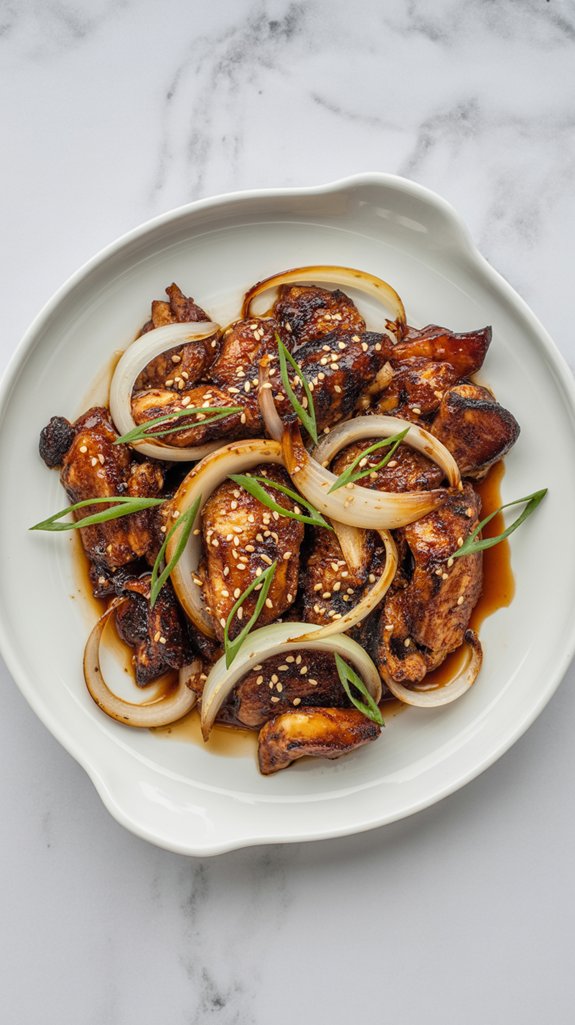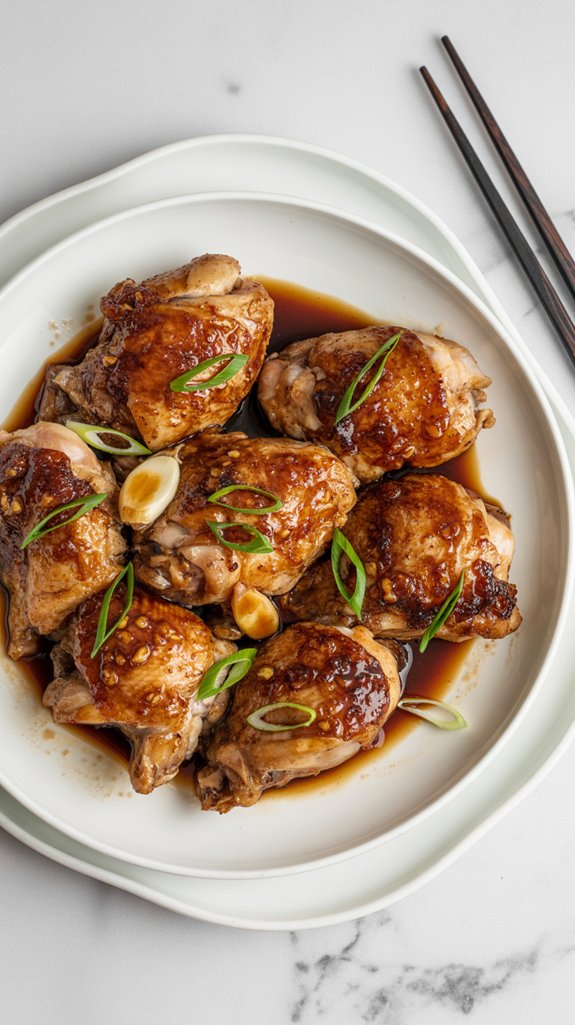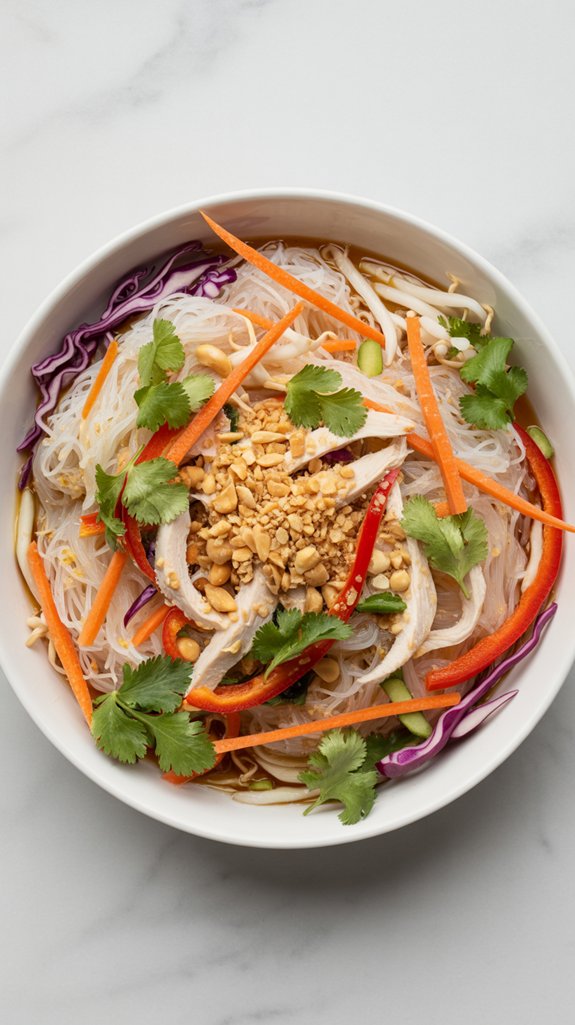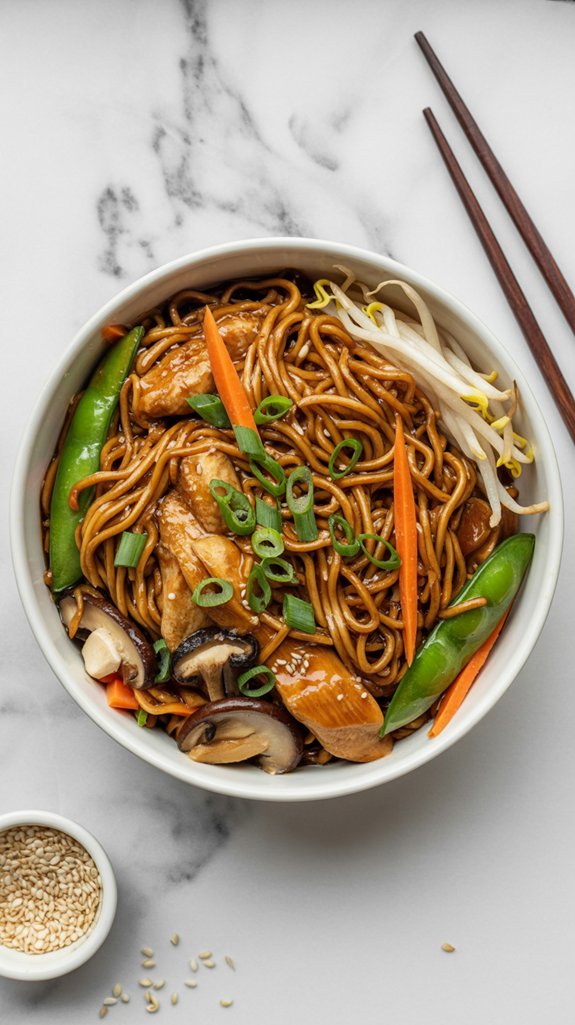Why You’ll Love This this Korean-Style Chicken Bulgogi
This Korean-inspired chicken bulgogi brings all those sweet, savory, umami flavors right to your dinner table with ingredients you probably already have in your pantry.
The marinade works its magic in just 30 minutes, which honestly feels like a miracle when you’re staring at bland chicken breasts wondering how to make them actually taste like something.
You get tender, flavorful chicken swimming in a glossy sauce that’s perfect for spooning over rice, and let’s be real, who doesn’t love a good sauce situation.
Ingredients List
Getting this Korean-style chicken bulgogi on your table starts with gathering just a handful of simple ingredients that pack serious flavor punch.
- 1 to 1 1/2 pounds stir fry style chicken (beef can be used)
- 3/4 cup light soy sauce (lite only)
- 6 tablespoons sugar
- 4 tablespoons vegetable oil (canola works too)
- 1 teaspoon pepper
- 1/2 teaspoon garlic powder
- 4 to 5 medium green onions, bulbs finely chopped
- 2 1/2 cups uncooked rice
A few things to keep in mind about these ingredients and your health:
- Using light soy sauce instead of regular helps cut down on sodium without sacrificing that deep, salty flavor we’re after.
- The sugar content is pretty standard for bulgogi marinades, but you could dial it back to 4 tablespoons if you’re watching your sugar intake.
- Opting for lean chicken breast or thighs keeps the protein high while the overall dish stays relatively light.
- All that garlic powder and pepper brings antioxidants to the party, which is always a win.
- Green onions add a nice pop of vitamins and minerals, plus they make everything look fancy.
Step by Step Directions
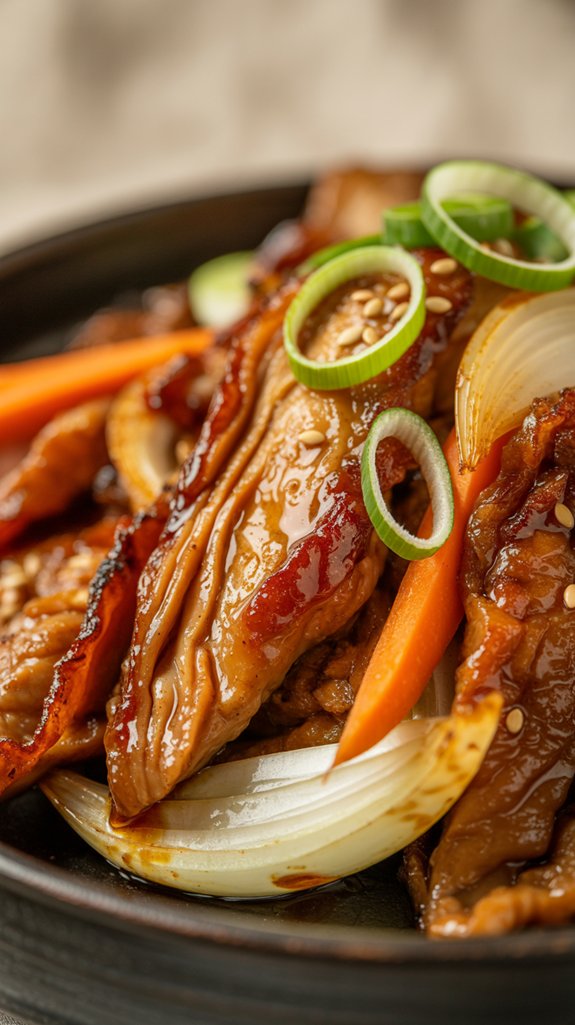
Making this Korean-style chicken bulgogi is straightforward and delivers restaurant-quality flavors right from your home kitchen.
- Cut chicken into bite-sized pieces and set aside.
- In a container or bowl with tight-fitting lid, mix together soy sauce, sugar, oil, pepper, and garlic powder.
- Stir until sugar is mostly dissolved.
- Add chicken and chopped green onions to the marinade.
- Stir until chicken is completely coated.
- Cover and refrigerate for 30 minutes to overnight (30 minutes is sufficient for chicken, while beef needs 2-3 hours).
- Cook rice according to package directions and set aside.
- Heat wok or deep fry pan with cooking spray over medium heat.
- Remove chicken from marinade using a slotted spoon.
- Cook chicken in the heated pan until done.
- Add the remaining marinade to the wok or pan.
- Heat the marinade through.
- Serve over prepared rice, spooning sauce over in desired amount.
For an authentic Korean dining experience, consider cooking this bulgogi on a Korean BBQ grill table which allows everyone to participate in the grilling process.
Substitutions and Variations
- Pork shoulder or thighs work too – Cut them thin like the chicken, and they’ll soak up that marinade like little flavor sponges.
- Coconut aminos for gluten-free folks – Swap out the soy sauce completely, though you might need a pinch more sugar since coconut aminos can be less salty.
- Add some fruit – Thinly sliced Asian pear or even regular pear in the marinade brings traditional Korean flavors and helps tenderize the meat naturally.
Additional Things to Serve With This Dish
This bulgogi pairs beautifully with so many things that you’ll probably end up making it twice a week just to try different combinations.
- Steamed white or brown rice – The classic choice that soaks up all that sweet-savory sauce like a dream.
- Korean lettuce wraps – Butter lettuce or red leaf lettuce makes perfect little pockets for the chicken, and honestly, it feels fancy even though it’s dead simple.
- Pickled vegetables – Quick cucumber pickles or store-bought kimchi cut through the richness and add that tangy crunch your taste buds are craving.
- Sesame green beans – Just like the recipe suggests, they’re the perfect green sidekick, especially if you toss them with a little sesame oil and garlic.
- Asian slaw – Shredded cabbage with rice vinegar dressing brings that fresh, crispy contrast that makes every bite interesting.
- Steamed broccoli or snap peas – Sometimes you just need more vegetables on the plate, and these work without competing with the main event.
- Fried rice – If you’re feeling ambitious and have leftover rice hanging around, why not turn this into a complete one-pan situation?
Cooking Tips & Tricks (Chef’s Notes)
After making this dish more times than I care to admit, I’ve picked up a few tricks that’ll save you from the rookie mistakes I definitely didn’t make myself.
- Don’t skip the marinating time – I know 30 minutes feels like forever when you’re hungry, but trust me, that’s when the magic happens and your chicken actually tastes like something worth writing home about.
- Pat your chicken dry before marinating – Wet chicken and marinade are like oil and water, except less science-y and more disappointing when your flavors don’t stick.
- Use a slotted spoon to remove the chicken – You want to save that liquid gold marinade for the sauce, not leave it clinging to your chicken like a needy friend.
- Don’t overcrowd your pan – Cook in batches if you need to, because steamed chicken is nobody’s friend, and we’re going for that beautiful caramelized look that makes people think you actually know what you’re doing.
- Let the marinade bubble and thicken – Once you add it back to the pan, give it a minute to reduce slightly so it coats everything like a glossy jacket instead of running off like water.
- Taste and adjust the sauce – Some soy sauces are saltier than others, so don’t be afraid to add a pinch more sugar if it needs balancing, because life’s too short for mediocre sauce.
- Prep everything first – This cooks fast once you start, so having your rice ready and your vegetables prepped means you won’t be scrambling around like a caffeinated squirrel.
Nutritional Facts
This Korean-style chicken bulgogi delivers solid protein while keeping things relatively balanced, especially when you consider how much flavor you’re getting per bite.
- Calories per serving: Approximately 520-580 calories (based on 4 servings)
- Protein: 35-40g per serving from the chicken, making this a protein powerhouse that’ll keep you satisfied
- Carbohydrates: 65-70g per serving, primarily from the rice with a small contribution from the sugar in the marinade
- Fat: 12-15g per serving, mostly from the vegetable oil used in the marinade
- Sodium: 1,200-1,400mg per serving due to the soy sauce – consider using low-sodium soy sauce if you’re watching your salt intake
- Sugar: 18-20g per serving from the marinade, which helps create that signature sweet-savory balance
- Fiber: 1-2g per serving, mainly from the green onions and rice
- Cholesterol: 85-95mg per serving from the chicken
- Iron: Good source due to the chicken and fortified rice
- Vitamin C: Small amount from the green onions
- Contains: Soy (from soy sauce), making it unsuitable for those with soy allergies
- Gluten status: Contains gluten from regular soy sauce – use tamari for gluten-free option
Fun “Did You Know?”
Did you know that bulgogi literally translates to “fire meat” in Korean, referring to the traditional grilling method over open flames?
I find it fascinating that this dish dates back to the Goguryeo period, making it over 2,000 years old. Originally, bulgogi was reserved for Korean royalty and special occasions due to expensive beef costs.
The sweet-savory marinade we love today developed during the Joseon Dynasty when sugar became more accessible.
While beef bulgogi remains traditional, chicken bulgogi like our recipe provides a lighter, more affordable alternative that’s gained popularity worldwide for its tender texture and quicker cooking time.

